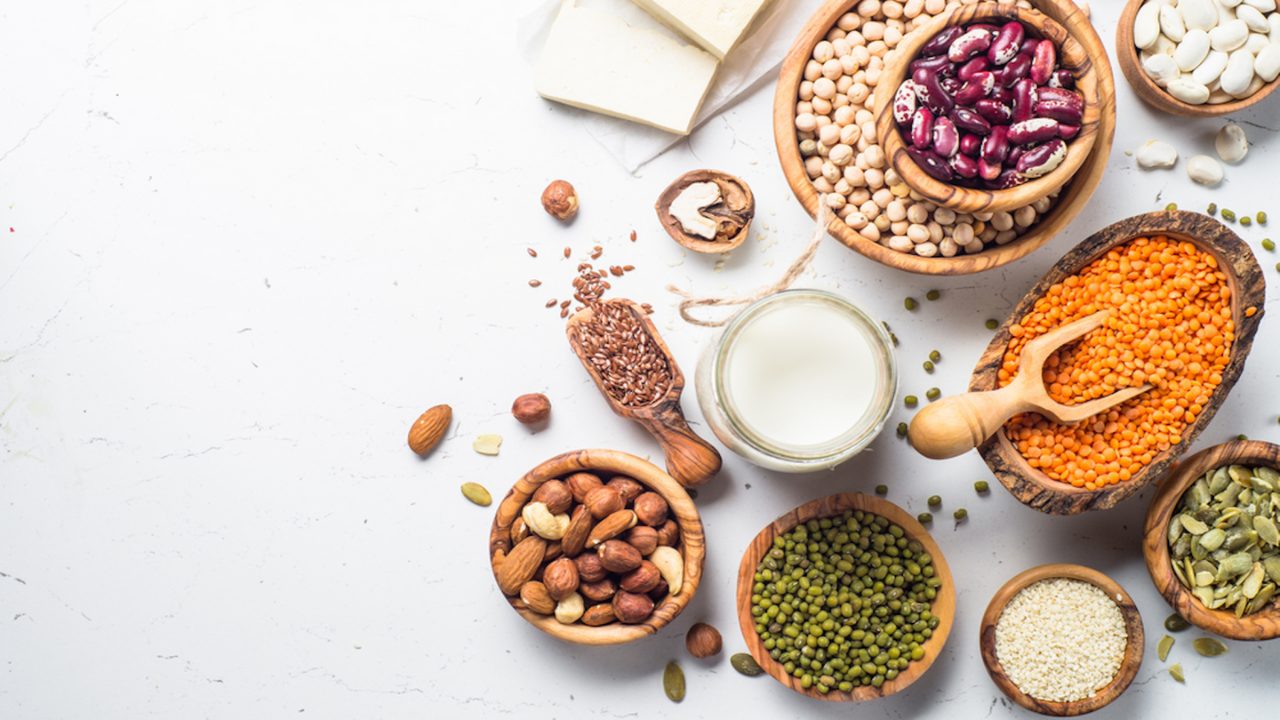Written by Gianina Padula. Medically reviewed by Diana Licalzi, MS, RD, CDE
When you think about protein, what comes to mind? For most, it may be something they consume only to build muscle; for others, perhaps something to keep them full. But, did you know that the source of protein may have more of an impact on your health than you think? Specifically, choosing plant proteins over animal proteins makes a drastic difference. Replacing meats with plant-based sources of protein correlates with better heart health, better management of cholesterol and body weight, and a lower overall occurrence of chronic disease -- even when fully adjusting for other lifestyle factors [1,4].
Protein Sources Provide Different Types of Fat
According to a 2017 review by the Physicians Committee of 49 studies observing vegan diets vs. omnivorous diets and their effect on plasma lipids (cholesterol), it has been shown that plant-based diets significantly lowered total cholesterol levels compared to diets including meat [9].
Animal proteins, especially red meats, contain a significant amount of saturated fat and cholesterol. Although new research has suggested the amount of cholesterol in food does not directly correlate with the cholesterol levels in one’s body, these levels are immensely impacted by the dietary consumption of saturated fats and trans fats [7].
There are two types of cholesterol in our bodies: high-density lipoprotein (HDL) and low-density lipoprotein (LDL). HDL is considered to be our body’s “good” cholesterol, while LDL is considered our “bad” cholesterol. The overconsumption of saturated fats can lead to elevated LDL levels [7].
On the other hand, plant proteins are low in saturated fats, completely void of cholesterol, and yet high in fiber; these characteristics all work to lower LDL levels [3]. Since our body produces all of the cholesterol it needs, there is no reason to be consuming excess cholesterol or saturated fat in one’s diet.

How Protein and Fiber Impact Type 2 Diabetes
Plant-based diets may both prevent and reverse type 2 diabetes. A 2018 study assessing the risk of pre- and type 2 diabetes found that plant proteins lowered insulin resistance [2]. High-saturated fat foods, on the contrary, such as animal protein, are associated with higher insulin resistance [8]. High insulin resistance has a direct correlation with type 2 diabetes risk, so it is important for prediabetics and those living with type 2 diabetes to steer clear of foods that lower insulin sensitivity.
As mentioned above, diets high in fiber come with their own benefits. Specific to diabetes, soluble fiber helps to slow the absorption of sugar, which leads to better blood sugar control [3]. Additionally, high-fiber foods are associated with reduced blood pressure and inflammation [3].

In a study examining the impacts of a high fiber diet vs. a moderate fiber diet in patients with type 2 diabetes, it was found that the high fiber diet resulted in better control of glucose and insulin spikes (shown above) [10]. Participants on the high-fiber diet also showed a significantly lower total cholesterol and triglyceride concentration than their counterparts [10].

Do Plant Proteins Need to be Combined?
Switching to a plant-based diet raises many questions. Some of these include whether foods need to be combined in order to make a “complete protein”, and how to navigate the preparation of new protein sources.
Do I need to focus on combining foods to get enough protein?
A food source is considered a complete protein when it contains an adequate amount of all nine essential amino acids: histidine, isoleucine, leucine, lysine, methionine, phenylalanine, threonine, tryptophan, and valine [6]. Essential amino acids must be consumed via our diets because our bodies cannot produce them. It used to be believed that plant-based proteins needed to be paired with a grain in order to be considered a complete protein. This was because plants were thought to be lacking in one or more essential amino acids, and the amino acids in grains would provide those that were missing.
This myth has since been debunked. In his video titled “The Protein Combining Myth,” Dr. Michael Greger shows that this antiquated belief originated from an article with no scientific evidence behind it [5]. In fact, it was largely spread in a 1975 issue of Vogue [5]. Despite the claim being refuted decades ago, it continued to be included in medicinal studies, including publications by the American Heart Association [5].
This led to a widespread misunderstanding and judgment of plant-based diets. This myth is invalid because, in actuality, plants contain all nine essential amino acids. Additionally, our bodies contain pools of amino acids that we are able to pull from to supplement those in our foods. The essential amino acids in meat originate from plants that are consumed by these animals [5]. We can therefore consume the same amounts of amino acids that meat offers through a plant-based diet alone.
Food prep: Where do I start?
When it comes to learning about the preparation of plant-based proteins, these ingredients can be more versatile than you think. Beans, quinoa, tofu, nuts, and seeds are just a handful of options available. You can use them in an array of ethnic dishes, fit them into any meal of the day, and combine them with spices and herbs to enhance the flavors. If you are looking for plant-based meal planning tips and recipe ideas, grab our free 7-day meal plan below!
References:
[1] https://academic.oup.com/advances/article/10/Supplement_4/S351/5624056
[2] https://link.springer.com/article/10.1007/s10654-018-0414-8
[3] https://www.mayoclinic.org/healthy-lifestyle/nutrition-and-healthy-eating/in-depth/fiber/
[4] https://pubmed.ncbi.nlm.nih.gov/26567196/
[5] https://nutritionfacts.org/video/the-protein-combining-myth/
[6] https://medlineplus.gov/ency/article/002222.htm
[7] https://www.cdc.gov/cholesterol/about/myths.html
[8] https://www.wellrx.com/news/saturated-fat-an-enemy-of-type-2-diabetes-control/
[9] https://academic.oup.com/nutritionreviews/article/75/9/683/4062197
[10] https://www.nejm.org/doi/full/10.1056/nejm200005113421903


What is the best type 2 diabetic protein powder?
We love Complement Protein Powder! We just wrote a blog about it. You can heck it out here: https://type2diabetesrevolution.com/complement-protein-review/